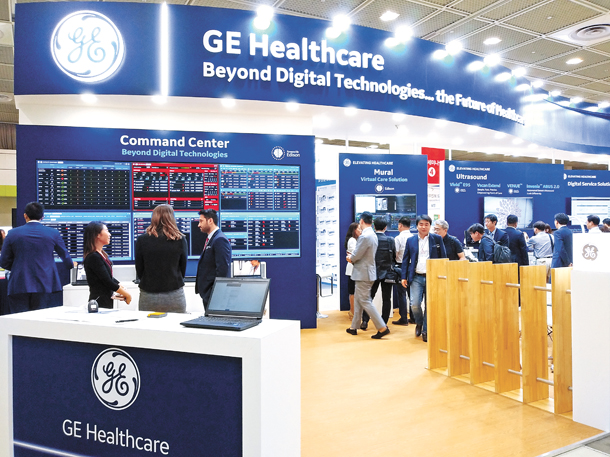Medical Mission Control arrives

Visitors take a look at GE Healthcare products, including the “Command Center” system, at the K-Hospital Fair held in Coex, southern Seoul, on Wednesday. The company is focusing on selling the high-tech management system to local hospitals as a cost-effective, smart digital solution. [KO JUN-TAE]
The health-care-specialized unit of Boston-based General Electric said during a press conference Wednesday that the center will use data to track patients through every step of their care, make operations more efficient and eliminate chronic delays and mistakes.
“In healthcare, there’s a data challenge,” said Kerrie Hauge, managing director at GE Healthcare who is in charge of the company’s Command Center business.
“We have an ocean of data, but the challenge is how to use it. It is difficult to find the information you need, and our Command Center can provide an opportunity to take the data already created and connect the dots to allow better use of that information.”
While many large-sized hospitals in Korea have adopted high-tech devices and implemented innovative surgical and diagnostic methods, the lack of digital management has created loopholes and inefficiencies and contributed to medical error, the company said.
According to the Korea Medical Dispute Mediation and Arbitration Agency, the number of mediation requests filed in regards to medical disputes reached 2,926 cases last year, up 21 percent from 2,420 cases in 2017.
At the moment, seven hospitals in the United States, England and Canada, including the Johns Hopkins Hospital, have adopted GE Healthcare’s Command Center solution.
Their Command Centers are decked out with large digital screens and analytics boards, reminiscent of NASA Mission Control.
GE Healthcare says the hospitals reported that wait times for beds in emergency rooms fell by 25 percent and the excess bed days fell by 52 percent. At the seven hospitals, beds were cleaned up to 45 percent faster than before, while fulfillment time for patient care requests was cut by 38 percent.
“The hospitals that have installed our Command Centers have been able to sustain their quality of care even when their beds were full,” Hauge added. “They are now confident that they can provide high-quality service to any patient.”
Korea University Hospital President Park Jong-hoon believes the adoption of digital-centric control systems, like those from GE Healthcare, will be an inevitable trend for all large-sized hospitals in the country.
He believes increasing efficiency while maintaining care quality is critical as aging populations often complicate the operations of hospitals while burdening patients and medical workers.
“The age of managing hospital solely with human resources has reached its limit,” Park said. “Machines are getting better, but patients are left out of the game. We need new digital systems to be more patient-centered and provide the best for everyone.”
While GE Healthcare did not say which hospital it is going to partner with in bringing the Command Center system to Korea, Hauge said “a large number of hospitals have expressed interest” in adopting the solution, adding that the company is currently working to modify its solution package to align it with local regulatory standards.
The cost for building a Command Center will be different for each hospital depending on the options chosen, she added.
BY KO JUN-TAE [ko.juntae@joongang.co.kr]










with the Korea JoongAng Daily
To write comments, please log in to one of the accounts.
Standards Board Policy (0/250자)